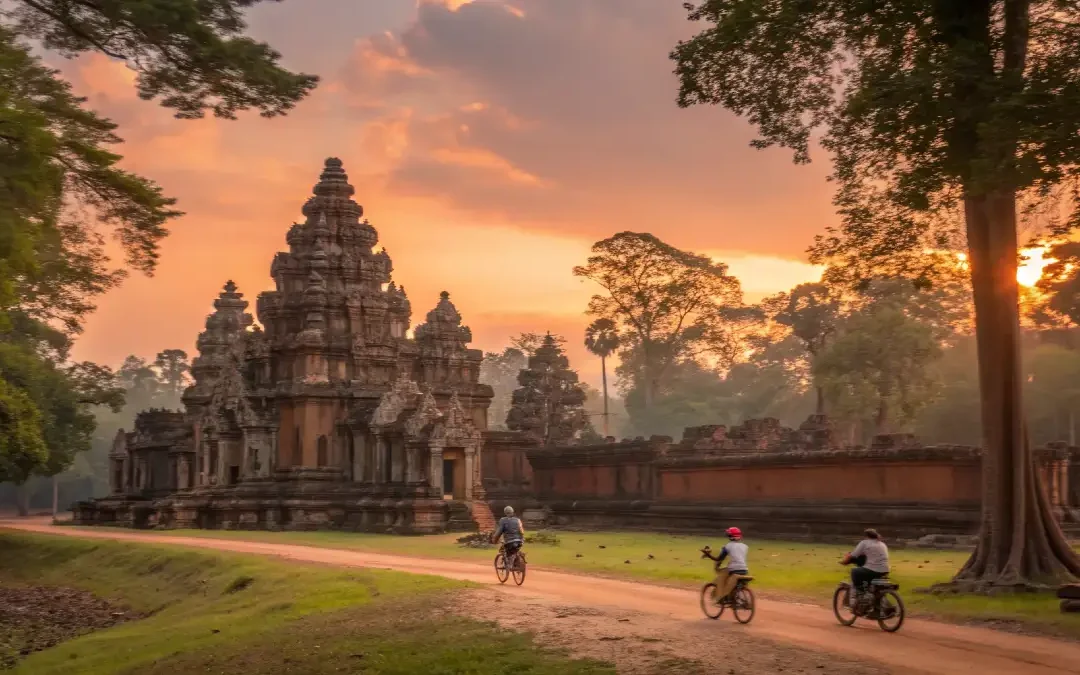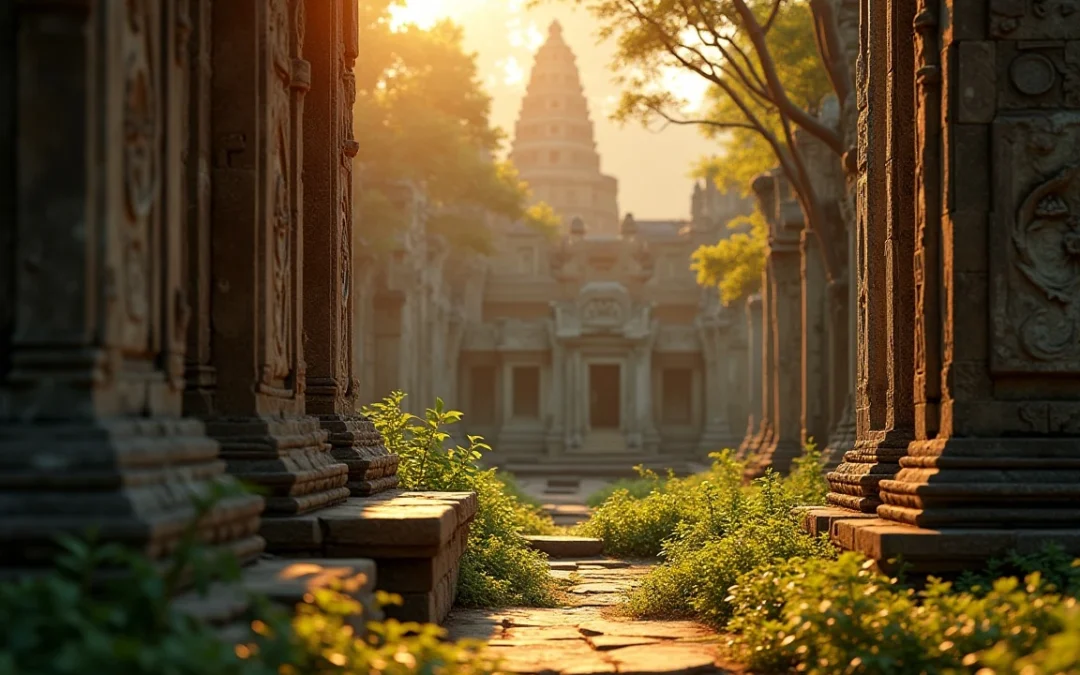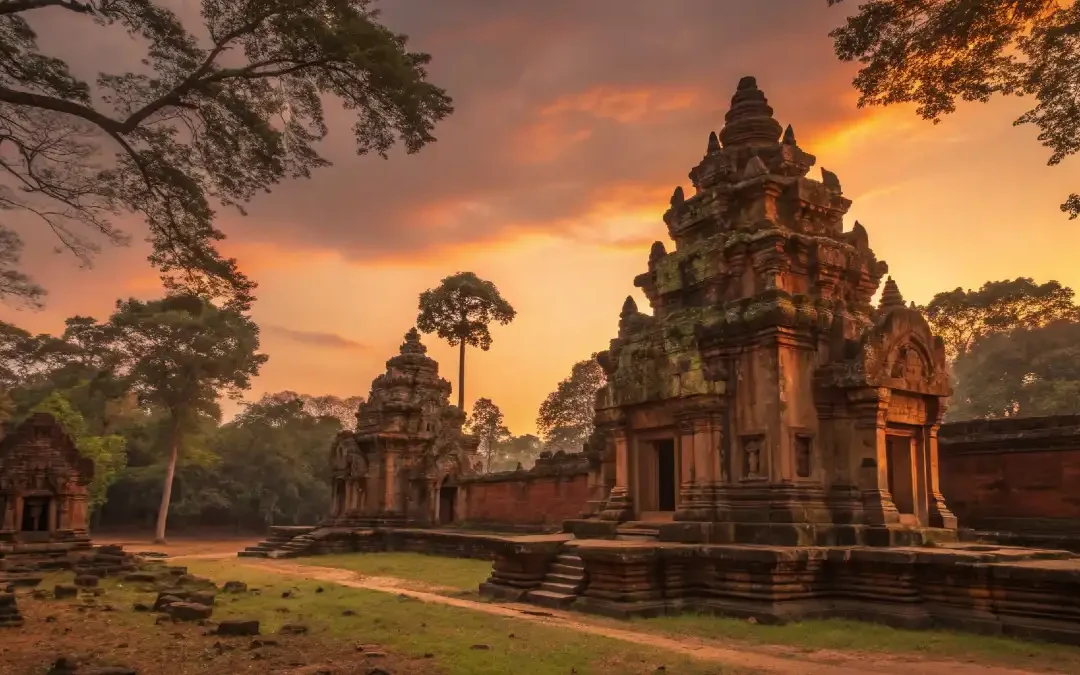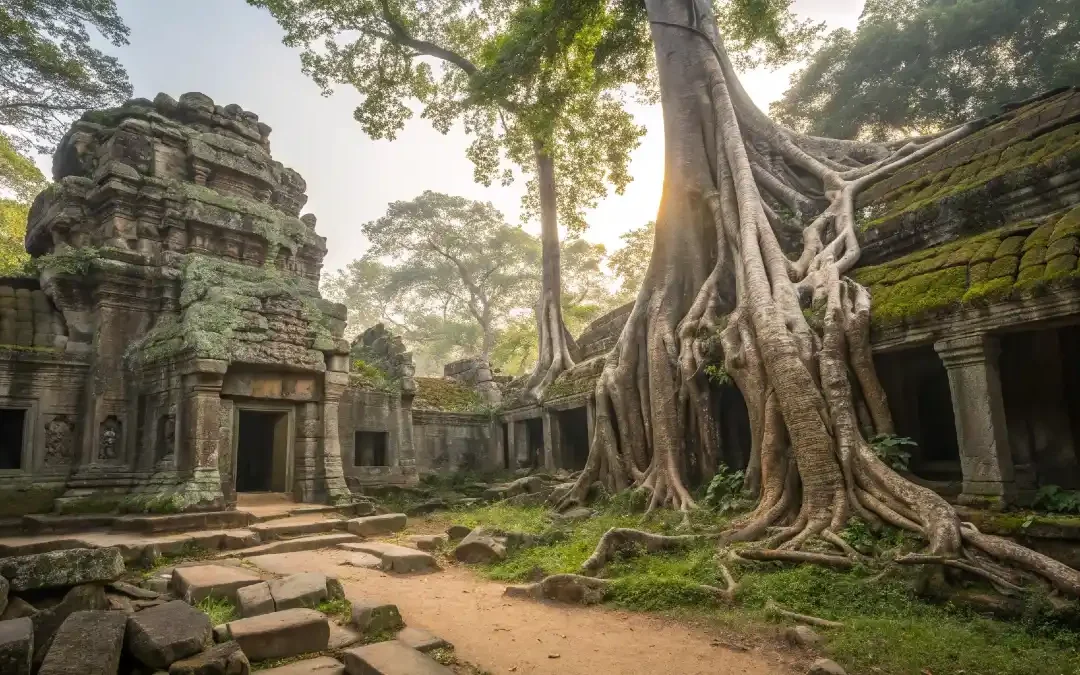Travel
Discover angkor’s hidden temples: journey beyond the crowds
Beyond the crowds, the secret temples of Angkor reveal a quieter, more immersive journey. These lesser-known sites, like Beng Mealea’s overgrown ruins (1.5 hours from Siem Reap), offer solitude and raw exploration. By venturing here, travelers gain deeper cultural insights, witness nature’s embrace of ancient architecture, and experience a Cambodia few encounter—transforming sightseeing into a personal, reflective adventure.
Tired of battling crowds at Angkor Wat’s iconic ruins? The secret temples of Angkor offer a quieter, more immersive journey through Cambodia’s ancient history. Picture yourself navigating the root-filled corridors of Beng Mealea, where nature reclaims stone dramatically, or admiring the cliffside grandeur of Preah Vihear, where panoramic views meet 11th-century artistry. These off the beaten path sites—like the moss-draped tranquility of Ta Nei or the forgotten pyramids of Koh Ker—invite you to explore history freely. Here, crumbling archways and hidden carvings reveal stories untouched by mass tourism, turning your visit into a transformative adventure where every step echoes the Khmer Empire’s silent legacy.
- Beyond the crowds: The allure of Angkor’s hidden temples
- Jungle-clad marvels: Temples reclaimed by nature
- Remote capitals and hilltop sanctuaires
- A gallery of hidden artistic masterpieces
- Practical guide to your Angkorian expedition
- Embracing responsible and respectful exploration
Beyond the crowds: The allure of Angkor’s hidden temples
An invitation to a different journey
Angkor’s iconic temples draw millions yearly, yet a quieter, more immersive experience awaits beyond the main pathways. Venturing into lesser-known sanctuaries like Temple of the Leopard or Prasat Kravan offers a chance to step into history untouched by crowds. Here, the silence is broken only by rustling leaves, inviting travelers to connect with the essence of Khmer civilization.
These sites demand curiosity. Why explore temples where moss blankets stone carvings and roots twist through ancient walls? Because they reveal stories of empires, faith, and resilience—narratives often drowned out by the buzz of popular sites. A journey here is not about ticking boxes but about feeling the weight of centuries.
Discovering history in silence
At Beng Mealea, pathways are blocked by fallen stones, urging visitors to climb and explore like early archaeologists. The lack of crowds amplifies the grandeur of its labyrinthine corridors. Nearby, Koh Ker’s pyramid, Prasat Chen, rises abruptly, defying expectations of Angkor’s typical layouts. Each temple’s unique architecture—a blend of symmetry and wild decay—tells a distinct chapter of Khmer ingenuity.
To preserve these sites, ethical practices are vital. Hiring local guides ensures respectful exploration while supporting communities. Avoid touching fragile carvings, and stick to marked trails. These temples, though remote, are not isolated from modern threats. Their survival hinges on balancing discovery with care, ensuring future generations can uncover their secrets too.
Jungle-clad marvels: Temples reclaimed by nature
Beng Mealea: The ultimate jungle temple adventure
Beng Mealea embodies the raw clash between human ambition and nature’s reclamation. Built in the 12th century as a possible prototype for Angkor Wat, its collapsed galleries and root-strangled corridors create an Indiana Jones-like maze. Visitors climb over debris, navigate shadowy passageways, and marvel at Spung trees whose roots grip sandstone like living fossils. The surrounding moats, now rainwater pools, nourish the very forces dismantling its walls—a paradox of preservation and decay. Its design mirrors Angkor Wat’s layout, with libraries and a central sanctuary, though its 180 lintels depicting Hindu epics remain half-buried in rubble, visible only during dry seasons.
- Climbing over collapsed sandstone galleries.
- Navigating through dark, root-filled corridors.
- Witnessing the sheer power of nature with giant Spung trees.
- Experiencing a true sense of discovery away from constructed walkways.
Located 70 km from Siem Reap, its remoteness ensures thinner crowds. Wooden walkways guide some paths, but true exploration means venturing off them. Monsoon rains (September-October) transform moss into emerald carpets, revealing hidden reliefs on fallen lintels. Sturdy shoes and local guides (around $5) are essential for safety and context about its Hindu-Buddhist fusion. Photographers favor this season, when rain-polished sandstone highlights carvings like a 12th-century Churning of the Ocean of Milk relief on a fallen lintel.
Ta Nei: A serene escape into the forest
Ta Nei offers tranquility through its isolation. Accessible via a dirt trail, this 12th-century Buddhist temple sits encircled by moats, its moss-covered walls echoing centuries of quiet devotion. Its 1881 inscription recounting Buddha’s travels remains untouched by tourism. Dense foliage and lack of infrastructure deter most visitors, preserving its untouched state. Morning light filters through the canopy, casting dappled patterns on sandstone. Ethical tourism here means avoiding contact with fragile carvings—each touch accelerates erosion. Unlike restored sites, its moss-covered reliefs and unexcavated debris fields remain intact, offering archaeologists clues about Angkor’s rural religious networks. The temple’s 13th-century re-carving of Buddhist figures into Hindu motifs hints at later religious shifts, though many details are softened by lichen.
Banteay Thom: Climbing through forgotten history
Banteay Thom reveals a rare Vishnu-on-Garuda sculpture coexisting with a Buddha image—a relic of the Khmer Empire’s religious shifts. This 13th-century site, crowned by a Spung tree, demands a 4WD vehicle. Its three crumbling towers frame a sky-piercing void, exposing the inner workings of Khmer construction. Fewer than 50 daily visitors make it a sanctuary for reflection. Climbing unstable blocks reveals hidden carvings eroded into abstract beauty. Preservation balances access with protection—ropes block fragile zones, while local guides share insights on Jayavarman VII’s reign. The temple’s iconography tells a story: a damaged lintel depicts the Great Departure of Prince Siddhartha, his horse Kantaka held aloft by gods. Supporting conservation means hiring local guides and avoiding physical contact with carvings. Its isolation ensures minimal intervention, letting the temple remain a living dialogue between human ambition and nature’s reclamation.
Remote capitals and hilltop sanctuaires
Hidden beyond Angkor Wat’s crowds lie temples that demand effort but reward visitors with solitude, grandeur, and living history. These sites, often requiring long journeys or challenging terrain, offer transformative journeys through Khmer heritage while emphasizing responsible tourism. Let’s explore three standout destinations where ancient architecture and cultural immersion converge.
Koh Ker: The forgotten capital’s pyramid
Once the 10th-century Khmer capital, Koh Ker’s remote location (2.5 hours from Siem Reap) preserves its aura of mystery. The seven-tiered Prasat Prang pyramid dominates the site—a 36-meter-high monument to Shiva, once housing the empire’s largest lingam. Wander among scattered ruins, half-swallowed by jungle, where few travelers venture.
Recent UNESCO recognition (2023) highlights its historical value, yet Koh Ker remains strikingly empty. Climb the reconstructed steps of Prasat Prang for panoramic views, or explore Prasat Krahom’s intact brick towers. Artifacts looted over decades now reside in Paris and Phnom Penh museums, underscoring the need for preservation. The Rahal reservoir, a 1.2km water management system, reveals advanced urban planning, while Prasat Neang Khmau’s scorched walls hint at ritual fires and forgotten ceremonies.
Preah Vihear: A clifftop temple with breathtaking views
Clinging to a 525-meter cliff, Preah Vihear rewards the 3-hour journey with sweeping vistas and architectural mastery. Built over centuries, this UNESCO site stretches 800 meters along a north-south axis—a departure from typical Khmer layouts. Five gopuras segment its ascent, each revealing more of the plains below.
Political tensions once limited access, but today’s visitors marvel at its pristine condition. Gray-and-yellow sandstone carvings remain vivid, while the layered approach—via causeways and staircases—echoes spiritual progression. The 2013 ICJ ruling affirming Cambodian ownership highlights modern preservation challenges. Celestial alignments of its causeways and 10th-century inscriptions by royal guru Divakarapandita add layers to its mystique, revealing a site shaped by faith and geopolitics.
Banteay Chhmar: The citadel of cats and living history
At Banteay Chhmar, crumbling walls etched with Lokeshvara’s 10-armed form reveal Jayavarman VII’s Buddhist vision. This “Citadel of Cats” (a name’s origin debated) sprawls across forests, its bas-reliefs depicting naval battles and mythic tales. Stay overnight in village homestays (from $8/night) to experience community-based tourism in action.
Local guides lead tours through face-towered gateways, explaining conservation efforts by groups like Global Heritage Fund. Participate in ox-cart tours ($10) or silk-weaving demos ($15) to directly support residents. With 70+ villagers involved in tourism, your visit fuels sustainable development—a model for ethical exploration in fragile heritage zones. The eastern gate’s rare Vishnu-Garuda-Buddha carving and evening traditional music performances ($20) offer immersive cultural connections beyond the ruins.
Travelers seeking depth over photo ops will find these temples redefine adventure. Each site’s isolation protects both their physical integrity and the authenticity of the experience. By prioritizing local guides, respecting access rules, and choosing community-run accommodations, visitors contribute to preservation while gaining unparalleled access to Cambodia’s soul. These temples aren’t just relics—they’re living testaments to a civilization’s ingenuity, waiting to be discovered by those willing to venture beyond the obvious.
Practical tips: For Koh Ker, bring insect repellent for jungle paths. At Preah Vihear, wear sturdy shoes for steep staircases. Banteay Chhmar’s homestays require advance booking during peak season (November–February). Always ask permission before photographing locals, and avoid touching carvings to prevent erosion—a small act with lasting impact.
A gallery of hidden artistic masterpieces
Banteay Srei: The citadel of women and its intricate carvings
Did you know a temple built in the 10th century still holds secrets in its stone? Banteay Srei’s pink sandstone walls glow under late afternoon light, revealing some of the finest carvings in the Khmer Empire. Unlike larger temples, its detailed reliefs depict full mythological scenes – Ravana shaking Mount Kailash, Krishna battling demons – carved with such precision they resemble woodwork.
Every surface tells a story. Look for the Gaja Lakshmi panel showing the goddess flanked by elephants, or the cosmic dance of Shiva. The three central towers symbolize the Hindu trinity, while guardian figures with animal faces stand watch. Visit during the golden hour to see sunlight animate the bas-reliefs, creating shadows that bring ancient tales to life.
Pro tip: Skip crowded morning tours. The temple’s smaller scale rewards patient exploration, and late visitors often share the site only with resident monks.
Sambor Prei Kuk: Pre-angkorian towers in the woods
Before Angkor’s golden age, Sambor Prei Kuk’s brick towers emerged from the jungle like ghosts of a forgotten kingdom. This 7th-century complex predates Angkor Wat by 300 years, its octagonal shrines and lotus-shaped towers marking the dawn of Khmer architecture. Would you believe these ruins hold the earliest known Khmer inscriptions?
Wander among 11 unique octagonal temples, their stone lions guarding pathways choked by roots. The Prasat Sambor group reveals India’s influence through Shivaite iconography, while the Lion Temple’s carvings show musicians and dancers. Why visit here? You’ll see how later masterpieces like Angkor Wat evolved – without battling crowds.
Getting around: Rent a bike to cover the 25 km² site. Morning visits let you spot wildlife before midday heat. Local guides know which shaded paths hide the best-preserved reliefs.
Banteay Prei: A quiet study in buddhist and hindu art
Why does this 12th-century temple remain so empty? Its remote location within Angkor Archaeological Park keeps most visitors away, creating rare intimacy with Khmer artistry. Banteay Prei’s six sandstone towers contain some of the most delicate apsara carvings – celestial dancers frozen mid-movement – and narrative lintels depicting Hindu epics.
Trace your fingers over the Vali and Sugriva battle scene, its details still sharp after 800 years. The central sanctuary’s pediments show Shiva’s cosmic dance, his flame halo framing Nandi the bull. This temple lets you picnic beside history – pack a lunch and eat under ancient spung trees where roots grip stones like protective hands.
Preservation matters: Touch carvings gently. The site’s fragility means visitors help protect it by respecting no-climb zones and supporting conservation initiatives through entrance fees.
Practical guide to your Angkorian expedition
Navigating the remote paths: Transportation and access
Reaching Angkor’s hidden temples requires thoughtful planning. For remote sites like Preah Vihear or Koh Ker, a private car with a driver remains the most comfortable option, especially for longer distances on uneven roads. Motorbikes provide agility for navigating narrow dirt tracks toward sites like Beng Mealea, ideal for those seeking adventure. For closer, forest-enshrouded temples such as Ta Nei, bicycles offer an eco-friendly, immersive way to explore isolated ruins without traffic. Each choice balances comfort, accessibility, and the thrill of discovery.
- Car with driver: Best for comfort on long journeys to remote sites like Preah Vihear or Koh Ker.
- Motorbike (with or without driver): Ideal for agility on narrow dirt tracks and for a more adventurous feel.
- Bicycle: A great option for exploring closer temples within the main park but off the main roads, like Banteay Prei or Ta Nei.
The value of a local guide
Engaging a local guide transforms a simple visit into a rich historical journey. Experienced guides know unmarked trails to temples like Banteay Thom and can decode intricate carvings that reveal stories of Khmer spirituality. Their expertise ensures compliance with preservation rules while uncovering lesser-documented sites. For example, a guide might point out the rare Spung tree entwined with ruins at Banteay Thom, explaining its symbolic significance. This local knowledge safeguards both cultural respect and personal safety, especially near restricted areas or unmarked paths.
Planning your visit: A comparative overview
| Temple | Approx. Distance from Siem Reap | Recommended Transport | Key Highlight |
|---|---|---|---|
| Beng Mealea | 65 km (1.5 hours) | Car or Motorbike | Ultimate jungle-clad ruins |
| Koh Ker | 120 km (2.5 hours) | Car | Forgotten capital with a unique pyramid |
| Banteay Srei | 37 km (45 mins) | Tuk-tuk or Car | Exquisite pink sandstone carvings |
| Ta Nei | ~5 km from main circuit | Bicycle or Motorbike | Peaceful and completely deserted forest temple |
| Preah Vihear | 200 km (3+ hours) | Car | Spectacular clifftop views |
Use this table to prioritize visits based on time, transport preferences, and desired atmosphere. For instance, Beng Mealea suits adventurers, while Preah Vihear demands a full-day commitment but rewards with unparalleled vistas. Always confirm entry fees and opening hours with guides to avoid disruptions. By choosing ethical operators and respecting local rules, you contribute to preserving these sites for future generations.
Embracing responsible and respectful exploration
The challenge of preserving forgotten temples
Many lesser-known temples of Angkor face a paradoxical threat. Their isolation shields them from crowds, yet exposes them to natural decay and limited restoration resources. Vegetation, while visually striking, can accelerate deterioration through root damage. Studies reveal that forests surrounding sites like Beng Mealea act as a protective shield, preserving 79% of sculptures compared to deforested Ta Keo’s 7%. Organizations like GoEco and the World Monuments Fund counter these risks through conservation projects in Banteay Chhmar and Preah Khan, where volunteers remove invasive vegetation and document endangered carvings. Modern challenges persist: unregulated groundwater extraction for tourism infrastructure risks destabilizing temple foundations, echoing historical deforestation that contributed to Angkor’s decline in the 15th century. These lessons underscore the delicate balance between preservation and progress.
How to be a mindful explorer
Responsible exploration begins with conscious choices. Follow these guidelines to protect Angkor’s hidden gems:
- Avoid climbing fragile structures or touching carvings to prevent irreversible erosion. Even light contact accelerates damage over time.
- Stick to marked paths to protect ancient stonework and root systems connected to temple foundations. Unregulated trails risk damaging hidden structural supports.
- Carry out all waste; leave no trace beyond footprints. Litter disrupts sanctity and harms wildlife, especially in remote areas with limited waste management.
- Support local economies by hiring community guides like Tong Hann or staying in family-run accommodations. This ensures tourism benefits residents rather than distant corporations.
- Dress respectfully, covering shoulders and knees, to honor cultural norms and sacredness. Modesty aligns with the reverence these sites inspire.
The spiritual dimension of the silent temples
Exploring Angkor’s forgotten sanctuaries transcends sightseeing. The hushed atmosphere of temples like Ta Nei or Banteay Thom invites introspection, echoing centuries of devotion. Moss-draped stones and intricate carvings, such as Banteay Thom’s Vishnu on Garuda over Buddha, reflect Khmer spiritual heritage’s syncretic traditions. The faint echoes of morning prayers at Ta Nei, where monks occasionally perform rituals, remind visitors that these structures are not relics but active spaces of faith. By engaging mindfully, travelers honor these sites as living testaments to a civilization’s connection to the divine. Ethical exploration ensures their legacy endures for future seekers of history’s quiet truths.
The secret temples of Angkor invite escaping the ordinary, where crumbling stones and tangled roots whisper forgotten tales. Hidden sanctuaries offer solitude, adventure, and connection to Cambodia’s soul. Venturing off the beaten path blends discovery with responsibility. Let Angkor’s silent wonders transform your journey, understanding of time, and creativity’s enduring power.






0 Comments